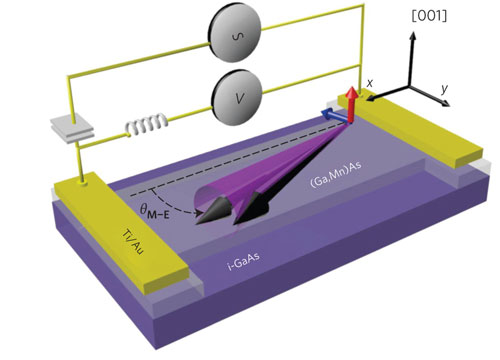| Mar 07, 2014 |
Quantum geometrical phase shakes a magnet - a new principle for future spin devices
|
|
(Nanowerk News) A new mechanism of controlling magnetic states by electric currents has been discovered through an internationally collaborative work, published in journal of Nature Nanotechnology ("An antidamping spin–orbit torque originating from the Berry curvature").
|
|
In particular, this mechanism exploits the quantum geometrical phase, the so-called Berry phase, existing in the momentum space of electronic band structures in specific materials.
|
 |
| Electrically shaken GaMnAs magnet in the experiments.
|
|
Current technologies for writing, storing, and reading information are either charge-based or spin-based. Semiconductor flash or random access memories are prime examples among the large variety of charge-based devices. These systems utilize the possibility offered by semiconductors to easily electrically manipulate and detect their electronic charge states representing the “zeros” and “ones”. The downside, however, is that weak perturbations such as impurities, temperature change, or radiation can lead to uncontrolled charge redistributions and, as a consequence, to data loss.
|
|
Spin-based devices operate on an entirely distinct principle. In some materials, like iron, electron spins generate magnetism and the position of the north and south pole of the magnet can be used to store the zeros and ones. This technology is behind memory applications ranging from kilobyte magnetic stripe cards to terabyte computer hard disks. As they are based on spin, the devices are much more robust against charge perturbations.
|
|
However, the drawback of current magnetic memories is that in order to reverse the north and south poles of the magnet, i.e. flip the zero to one or vice versa, the magnetic bit has to be coupled to an electro-magnet or to another permanent magnet. If instead one could flip the poles by an electric signal without involving another magnet, a new generation of memories can be envisaged combining the merits of both charge and spin-based devices.
|
|
In order to control a magnet electrically without involving an electro-magnet or another permanent magnet one has to step out of the realm of classical physics and enter the relativistic quantum mechanics. Einstein’s relativity allows electrons accelerated in an electric field to order their spins, in other words, to become magnetic.
|
|
In this study, the researchers, including lead author Hide Kurebayashi, from the LCN, took a permanent magnet GaMnAs and accelerated some of the electrons inside the permanent magnet by electric field. These accelerated electrons created a new internal magnetic cloud which was able to interact and control the surrounding permanent magnet, and the researchers detected that the poles of the permanent magnet moved.
|
|
Dr Kurebayashi commented “Exemplified by our work, the spin-orbit interaction offers remarkable opportunities for creating and detecting spins by an electric means. We will pursue the power of the spin-orbit interaction further in our research, in a view of using it for future nano-electronic devices.”
|

